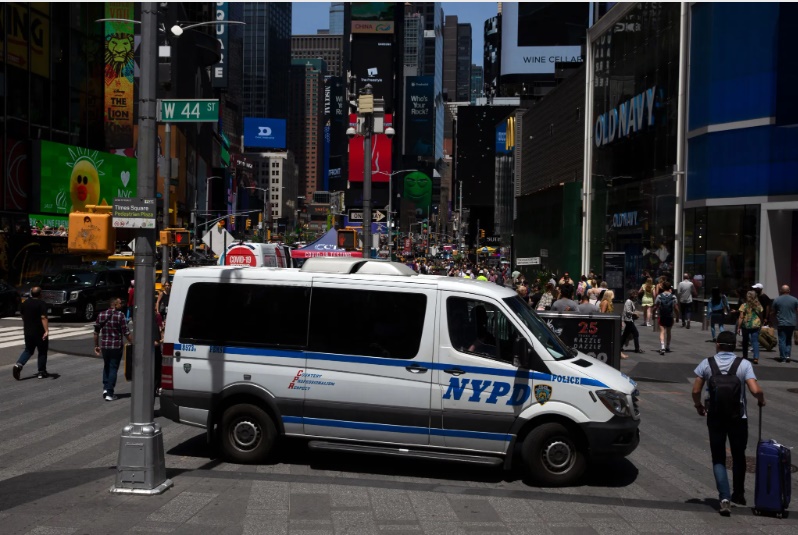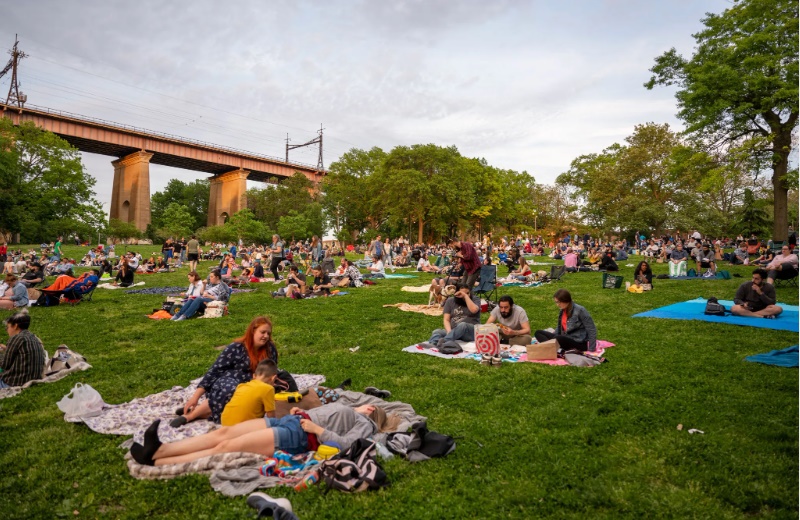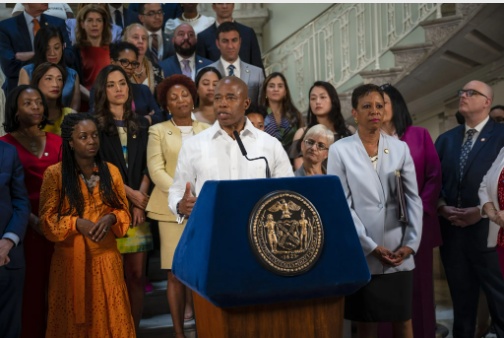
Mayor Eric Adams embraces Council Speaker Adrienne Adams at City Hall after announcing a budget deal June 10, 2022.Hiram Alejandro Durán/THE CITY

This article was originally published by The CITY on June 10
Mayor Eric Adams and the City Council on Friday agreed on a $101 billion budget that promises to increase funding for parks and childcare, and boost trash pickup — while also adding to the city’s rainy-day reserves.
Council Speaker Adrienne Adams noted that the budget is bigger than the $98.7 billion executive proposal the mayor released in April and includes some of the Council’s priorities. Those include a property tax rebate for some 600,000 households and more money for human and legal services providers who are contracted by the city.
“At this significant juncture for our city, this Council has recognized that the strength of our communities is critical,” she said during Friday’s announcement in the City Hall rotunda, known to insiders as the “handshake.” “We know that in order for our communities to be safe and for our city to be stronger, we have to invest in New Yorkers.”
The budget deal was eased by an extra $4.5 billion in tax revenue recently recognized — mostly as a result of the enormous profits made on Wall Street last year. Weeks ago, both the city and state comptrollers had estimated that the city would collect up to $3 billion more in revenue for the fiscal year ending June 30 than the mayor had projected in his executive budget. And on Friday, the mayor revealed an additional $1.5 billion in expected tax receipts.
He said the budget deal — reached nearly three weeks before its deadline, earlier than it has been in years — reflected a new type of management in New York.
“You can look at the leadership of the city and see what the possibilities are,” Adams said.
Absent from the Council and City Hall’s budget statement summarizing the deal, however, was any mention of major health initiatives — coming after two years of the deadly COVID-19 pandemic, which has killed more than 40,500 New Yorkers.
Representatives for the mayor and the speaker did not immediately respond to requests for comment.
Friday’s announcement — including a celebratory handshake and cheers was big on generalizations, small on details. The full budget breakdown is expected to be available ahead of the Council’s vote to approve it.
Here are a few of the biggest issues the budget addresses:
Public Safety
The NYPD budget is expected to remain the same as it was last year, around $6 billion, the speaker and mayor said at Friday’s briefing.
The move comes two years after calls to “defund the police” roiled the Council’s budget vote following the murder of George Floyd in Minnesota and protests throughout the city.
Critics said the NYPD budget should have been reduced, with the money allocated to other agencies and services.
“Mayor Adams’ budget will not make our communities safer, and instead will undermine the real sources of community safety, stability and well-being,” New York City’s Democratic Socialists of America co-chair Sumathy Kumar said in a statement. “By cutting funding for schools and housing when the city is flush with resources, Mayor Adams’s first budget fails working-class New Yorkers.”

An NYPD van in Times Square, June 8, 2022.Ben Fractenberg/THE CITY
Mayor Adams also touted the addition of 1,400 Safe Haven beds for New Yorkers experiencing homelessness and needing social services, costing approximately $226 million, according to City Hall. The budget deal also allegedly includes spending $54 million to expand a program that looks to redirect people at risk of participating in gun violence into jobs.
Cut from the final budget was Mayor Adams’ proposal to add nearly 600 more officers to the Department of Correction, which has been beset with staffing problems and jail chaos, including an unusually high number of detainee deaths.
Green Space
Although he vowed while campaigning to devote 1 percent of the city’s overall budget to the Department of Parks and Recreation, this year’s funding for the city’s green spaces is expected to only increase slightly above its current $563 million, according to an official familiar with the finalized budget. That’s still only about half a percent.
The increase includes $43 million for maintenance and upgrades of parks, and $4 million to add 50 more Urban Park Rangers.
The budget also adds $488 million in capital funds for projects like planting 20,000 new trees and fixing swimming pools.

People gather in Astoria Park ahead of an outdoor movie, May 21, 2021.Hiram Alejandro Durán/THE CITY
Councilmember Shekar Krishnan (D-Queens), chair of the Committee on Parks and Recreation, called the deal a win.
“We achieved baselined, permanent funding to protect the jobs of hundreds of parks workers that were set to expire imminently,” he told THE CITY, noting the budget saved hundreds of jobs, including 50 community gardeners.
“We fought to win funding for our natural areas, forestry, and Green Thumb gardens. We fought to restore funding for parks equity.”
Schools
The city’s public school system faces its first budget in two years that doesn’t include federal stimulus money — while dealing with a 6.4% drop in enrollment since the pandemic began.
Friday’s budget deal statement didn’t include many details on the Department of Education, but school leaders were reportedly prepared for cuts to programs or to limit plans to hire more teachers.
“Our schools have endured the hardest two years and need every penny to provide the social, emotional, and academic supports that all our students deserve this summer and fall,” said Comptroller Brad Lander.
The Council and the mayor’s office noted increases to the Summer Rising school enrichment program, adding funding for 10,000 more slots, bringing the total capacity to 210,000, officials said, at a cost of $101 million.
The new budget will also include $50 million to upgrade cafeterias at 100 schools, according to City Hall.
Helping Hands
Included in the budget is continued funding for Fair Fares, which provides discounted MetroCards for low-income New Yorkers.
House, co-op and condo owners, approximately 600,000 of them across the five boroughs, will each receive their share of a $90 million property tax rebate — shaking out to $150 a household, officials said.
The budget also includes $19.2 million next year to provide child care vouchers for low-income and immigrant families.
Trash City
The new budget includes an additional $22 million for the Department of Sanitation to restore street corner litter basket service to pre-pandemic levels.
There’s also $5 million to add 1,000 rat-resistant public garbage cans and fund a study to look at a possible waste containerization program, which would create a system to store outdoor household trash in large bins, according to the City Hall.

Historic Seward Park on the Lower East Side, June 10, 2022.Hiram Alejandro Durán/THE CITY
“Nobody wants dirty streets … it’s just unpleasant to live,” the mayor said at the budget press conference Friday afternoon. “And let’s be clear: I hate rats.”
Adams famously proposed traps using an acidic concoction of chemicals to liquify rats while Brooklyn borough president in 2019.
Housing
As rents continue to rise across New York, the budget adds $5 billion in capital funds to the city’s Department of Housing Preservation and Development — bringing the agency’s total capital funding to $22 billion over 10 years, officials said.
Mayoral spokesperson Jonah Allon said the additional funding will allow HPD to continue its pace of development amidst rising costs and inflation over the next decade. The money will also go toward rehabilitating thousands of units of public housing, he added.
But some said it isn’t enough to offer relief to New Yorkers struggling to pay the rent and find an affordable place to live — as the median rent for available Manhattan apartments reached historic highs this week.
Lander hoped for more capital funding for housing, given rising costs.
“Housing remains a big challenge and they are worried about their ability to spend all that money,” he told THE CITY.
Saving Up
The final budget deal also adds $2 billion to reserves set aside to prevent major budget cuts in the event of an economic downturn, bringing the total to more than $8 billion.
The agreement provides $750 million to establish a new rainy-day fund, $750 million to the retiree health benefits trust that has been used to plug holes in previous budgets, and $500 million to the general reserve.
In addition, the deal between the mayor and the Council adds money to the city’s set aside to cover future pay raises, bringing it to almost $3 billion. But that amount would only cover annual bumps of less than 2 percent, a figure that seems unlikely given a New York inflation rate running at a little over 6% annually.

Mayor Eric Adams at City Hall, June 10, 2022.Hiram Alejandro Durán/THE CITY
“There is a recognition by the mayor and Council that the robust gain in revenues is not likely to continue, and there is more anxiety about the possibility of a downturn, and that has to give you a lot of pause,” said Lander.
Adams aides said the budget gaps in future years, which average about $4 billion per year, are “manageable.”
Andrew Rein, president of the Citizens Budget Commission, disagrees. “When you look at the need to negotiate labor contracts, the economic risks and the fiscal cliffs as federal money used to fund continuing programs runs out, you are going to be managing budget gaps much bigger than the $4 billion reported,” he said.
Lander too warned of possible trouble ahead.
The gaps are manageable if there is a downturn and if the city cuts $4 billion from the budget two years from now. You can — but it is extremely painful,” he said.
THE CITY is an independent, nonprofit news outlet dedicated to hard-hitting reporting that serves the people of New York.
